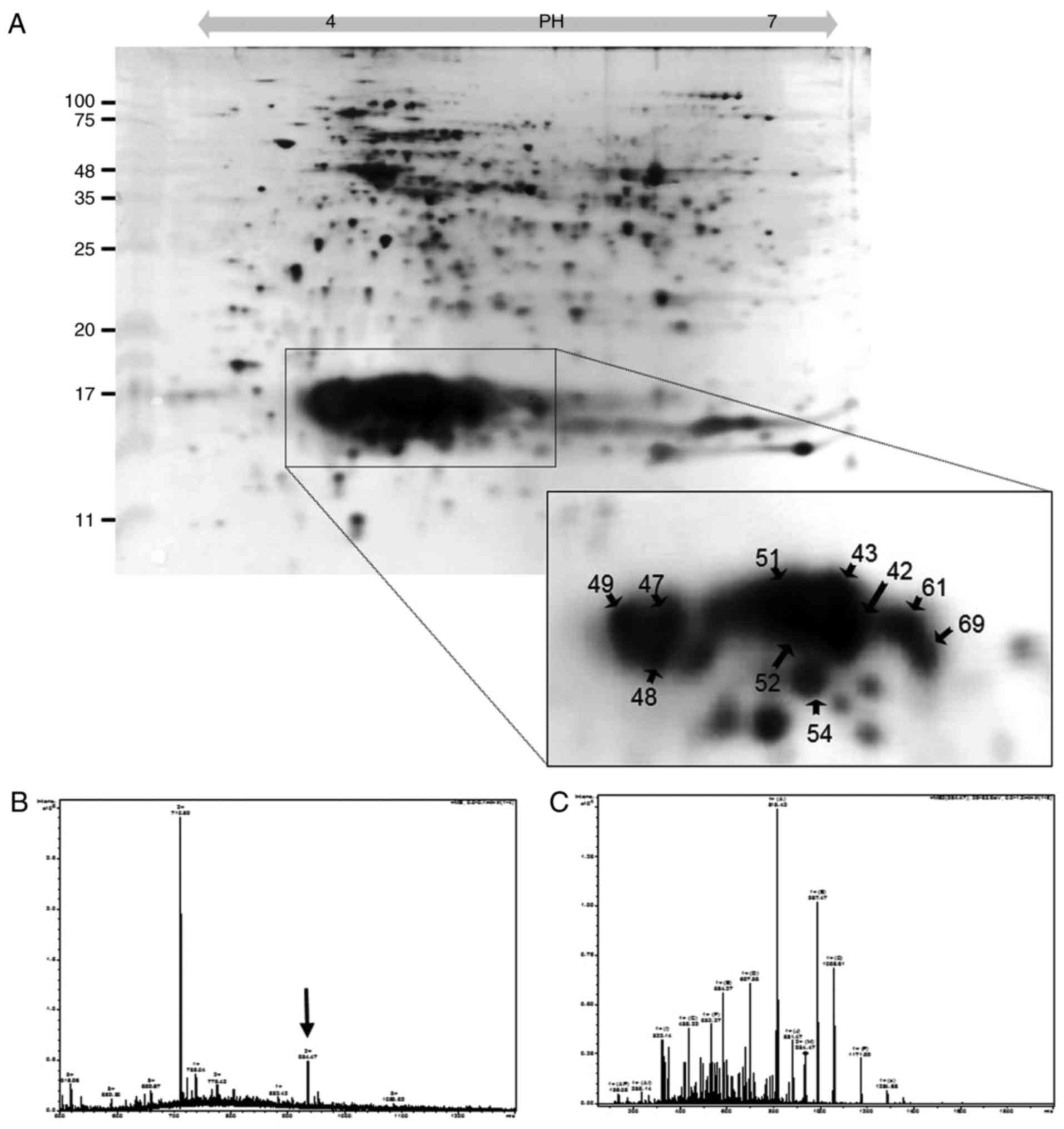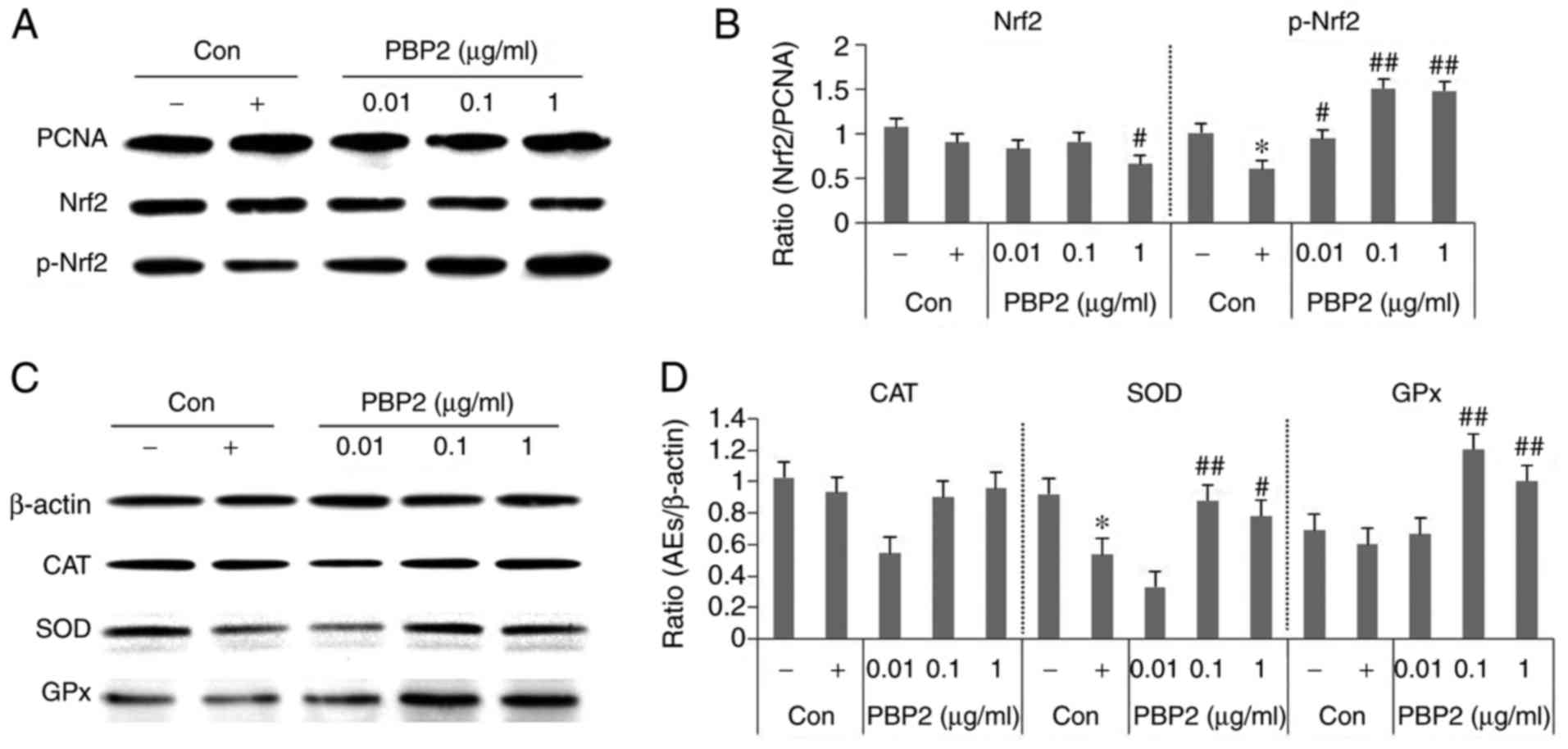|
1
|
Pádua D, Rocha E, Gargiulo D and Ramos AA:
Bioactive compounds from brown seaweeds: Phloroglucinol,
fucoxanthin and fucoidan as promising therapeutic agents against
breast cancer. Phytochem Lett. 14:91–98. 2015. View Article : Google Scholar
|
|
2
|
Pérez MJ, Falqué E and Dominguez H:
Antimicrobial action of compounds from marine seaweed. Mar Drugs.
14:e522016. View Article : Google Scholar : PubMed/NCBI
|
|
3
|
Magalhaes KD, Costa LS, Fidelis GP,
Oliveira RM, Nobre LT, Dantas-Santos N, Camara RB, Albuquerque IR,
Cordeiro SL, Sabry DA, et al: Anticoagulant, antioxidant and
antitumor activities of heterofucans from the seawee Dictyopteris
delicatula. Int J Mol Sci. 12:3352–3365. 2011. View Article : Google Scholar :
|
|
4
|
Cunha L and Grenha A: Sulfated seaweed
polysaccharides as multifunctional materials in drug delivery
applications. Mar Drugs. 14:E422016. View Article : Google Scholar : PubMed/NCBI
|
|
5
|
Michalak I and Chojnacka K: Algae as
production systems of bioactive compounds. Eng Life Sci.
15:160–176. 2015. View Article : Google Scholar
|
|
6
|
Harnedy PA and FitzGerald RJ: Bioactive
proteins, peptides, and amino acids from macroalgae(1). J Phycol.
47:218–232. 2011. View Article : Google Scholar : PubMed/NCBI
|
|
7
|
López-Cristoffanini C, Zapata J, Gaillard
F, Potin P, Correa JA and Contreras-Porcia L: Identification of
proteins involved in desiccation tolerance in the red seaweed
Pyropia orbicularis (Rhodophyta, Bangiales). Proteomics.
15:3954–3968. 2015. View Article : Google Scholar : PubMed/NCBI
|
|
8
|
Cai C, Li C, Wu S, Wang Q, Guo Z and He P:
Large scale preparation of phycobiliproteins from Porphyra
yezoensis using co-precipitation with ammonium sulfate. Nat Sci.
4:536–543. 2012.
|
|
9
|
Jensen GS, Attridge VL, Beaman JL, Guthrie
J, Ehmann A and Benson KF: Antioxidant and anti-inflammatory
properties of an aqueous cyanophyta extract derived from
Arthrospira platensis: Contribution to bioactivities by the
non-phycocyanin aqueous fraction. J Med Food. 18:535–541. 2015.
View Article : Google Scholar : PubMed/NCBI
|
|
10
|
Manirafasha E, Ndikubwimana T, Zeng X, Lu
Y and Jing K: Phycobiliprotein: Potential microalgae derived
pharmaceutical and biological reagent. Biochem Eng J. 109:282–296.
2016. View Article : Google Scholar
|
|
11
|
Hemlata and Fatma T: Screening of
cyanobacteria for phycobiliproteins and effect of different
environmental stress on its yield. Bull Environ Contam Toxicol.
83:509–515. 2009. View Article : Google Scholar : PubMed/NCBI
|
|
12
|
Reis A, Mendes A, Lobo-Fernandes H, Empis
JA and Novais JM: Production, extraction and purification of
phycobiliproteins from Nostoc sp. Bioresour Technol. 66:181–187.
1998. View Article : Google Scholar
|
|
13
|
Sonani RR, Singh NK, Kumar J, Thakar D and
Madamwar D: Concurrent purification and antioxidant activity of
phycobiliproteins from Lyngbya sp. A09DM: An antioxidant and
anti-aging potential of phycoerythrin in Caenorhabditis elegans.
Process Biochem. 49:1757–1766. 2014. View Article : Google Scholar
|
|
14
|
Dey A and Cederbaum AI: Alcohol and
oxidative liver injury. Hepatology. 43:S63–S74. 2006. View Article : Google Scholar : PubMed/NCBI
|
|
15
|
Loguercio C and Federico A: Oxidative
stress in viral and alcoholic hepatitis. Free Radic Biol Med.
34:1–10. 2003. View Article : Google Scholar
|
|
16
|
Mayoral W and Lewis JH: Drug-induced liver
disease. Curr Opin Gastroenterol. 16:231–238. 2000. View Article : Google Scholar
|
|
17
|
López-Terrada D, Cheung SW, Finegold MJ
and Knowles BB: Hep G2 is a hepatoblastoma-derived cell line. Hum
Pathol. 40:1512–1515. 2009. View Article : Google Scholar : PubMed/NCBI
|
|
18
|
Nowrouzi A, Meghrazi K, Golmohammadi T,
Golestani A, Ahmadian S, Shafiezadeh M, Shajary Z, Khaghani S and
Amiri AN: Cytotoxicity of subtoxic AgNP in human hepatoma cell line
(HepG2) after long-term exposure. Iran Biomed J. 14:23–32.
2010.PubMed/NCBI
|
|
19
|
Yook JS, Kim M, Pichiah PB, Jung SJ, Chae
SW and Cha YS: The antioxidant properties and inhibitory effects on
HepG2 cells of chicory cultivated using three different kinds of
fertilizers in the absence and presence of pesticides. Molecules.
20:12061–12075. 2015. View Article : Google Scholar : PubMed/NCBI
|
|
20
|
Martín MA, Ramos S, Mateos R,
Izquierdo-Pulido M, Bravo L and Goya L: Protection of human HepG2
cells against oxidative stress by the flavonoid epicatechin.
Phytother Res. 24:503–509. 2010.
|
|
21
|
Salla S, Sunkara R, Ogutu S, Walker LT and
Verghese M: Antioxidant activity of papaya seed extracts against
H2O2 induced oxidative stress in HepG2 cells.
LWT-Food Sci Tech. 66:293–297. 2016. View Article : Google Scholar
|
|
22
|
Zhao J, Ma D, Luo M, Wang W, Zhao C, Zu Y,
Fu Y and Wink M: In vitro antioxidant activities and antioxidant
enzyme activities in HepG2 cells and main active compounds of
endophytic fungus from pigeon pea [Cajanus cajan (L.) Millsp]. Food
Res Int. 56:243–251. 2014. View Article : Google Scholar
|
|
23
|
Song JS, Kim EK, Choi YW, Oh WK and Kim
YM: Hepatocyte-protective effect of nectandrin B, a nutmeg lignan,
against oxidative stress: Role of Nrf2 activation through ERK
phosphorylation and AMPK-dependent inhibition of GSK-3β. Toxicol
Appl Pharmacol. 307:138–149. 2016. View Article : Google Scholar : PubMed/NCBI
|
|
24
|
Tsai TH, Yu CH, Chang YP, Lin YT, Huang
CJ, Kuo YH and Tsai PJ: Protective effect of caffeic acid
derivatives on tertbutyl hydroperoxide-induced oxidative
hepatotoxicity and mitochondrial dysfunction in HepG2 cells.
Molecules. 22:E7022017. View Article : Google Scholar
|
|
25
|
Martín MA, Ramos S, Mateos R, Granado
Serrano AB, Izquierdo-Pulido M, Bravo L and Goya L: Protection of
human HepG2 cells against oxidative stress by cocoa phenolic
extract. J Agric Food Chem. 56:7765–7772. 2008. View Article : Google Scholar : PubMed/NCBI
|
|
26
|
Martín MA, Ramos S, Granado-Serrano AB,
Rodríguez-Ramiro I, Trujillo M, Bravo L and Goya L: Hydroxytyrosol
induces antioxidant/detoxificant enzymes and Nrf2 translocation via
extracellular regulated kinases and
phosphatidylinositol-3-kinase/protein kinase B pathways in HepG2
cells. Mol Nutr Food Res. 54:956–966. 2010. View Article : Google Scholar : PubMed/NCBI
|
|
27
|
Sonani RR, Rastogi RP and Madamwar D:
Antioxidant potential of phycobiliproteins: Role in anti-aging
research. Biochem Anal Biochem. 4:2015. View Article : Google Scholar
|
|
28
|
Wessel D and Flugge UI: A method for the
quantitative recovery of protein in dilute solution in the presence
of detergents and lipids. Anal Biochem. 138:141–143. 1984.
View Article : Google Scholar : PubMed/NCBI
|
|
29
|
Abu-Reidah IM, Arráez-Román D,
Quirantes-Piné R, Fernández- Arroyo S, Segura-Carretero A and
Fernández-Gutiérrez A: HPLC- ESI-Q-TOF-MS for a comprehensive
characterization of bioactive phenolic compounds in cucumber whole
fruit extract. Food Res Int. 46:108–117. 2012. View Article : Google Scholar
|
|
30
|
Sonani RR, Rastogi RP, Patel R and
Madamwar D: Recent advances in production, purification and
applications of phycobiliproteins. World J Biol Chem. 7:100–109.
2016. View Article : Google Scholar : PubMed/NCBI
|
|
31
|
Cornish ML and Garbary DJ: Antioxidants
from macroalgae: Potential applications in human health and
nutrition. Algae. 25:155–171. 2010. View Article : Google Scholar
|
|
32
|
Cheung RC, Ng TB and Wong JH: Marine
peptides: Bioactivities and applications. Mar Drugs. 13:4006–4043.
2015. View Article : Google Scholar : PubMed/NCBI
|
|
33
|
Sobiechowska-Sasim M, Stoń-Egiert J and
Kosakowska A: Quantitative analysis of extracted phycobilin
pigments in cyanobacteria-an assessment of spectrophotometric and
spectrofluorometric methods. J Appl Phycol. 26:2065–2074. 2014.
View Article : Google Scholar : PubMed/NCBI
|
|
34
|
Galland-Irmouli AV, Pons L, Luçon M,
Villaume C, Mrabet NT, Guéant JL and Fleurence J: One-step
purification of R-phycoerythrin from the red macroalga Palmaria
palmata using preparative polyacrylamide gel electrophoresis. J
Chromatogr B Biomed Sci Appl. 739:117–123. 2000. View Article : Google Scholar : PubMed/NCBI
|
|
35
|
Wang L, Qu Y, Fu X, Zhao M, Wang S and Sun
L: Isolation, purification and properties of an R-phycocyanin from
the phycobilisomes of a marine red macroalg Polysiphonia urceolata.
PLoS One. 9:e878332014. View Article : Google Scholar
|
|
36
|
Wang Y, Gong X, Wang S, Chen L and Sun L:
Separation of native allophycocyanin and R-phycocyanin from marine
red macroalg Polysiphonia urceolata by the polyacrylamide gel
electrophoresis performed in novel buffer system. PLoS One.
9:e1063692014. View Article : Google Scholar
|
|
37
|
Hwang MS, Kim SO, Lee YS, Park EJ, Kim SC,
Ha DS, Gong YG, Baek J and Choi HG: Isolation and characterization
of pure lines of pigmentation and morphological mutants in Porphyra
tenera Kjellman (Bangiales, Rhodophyta). Kor J Fish Aquat Sci Doi.
2010.
|
|
38
|
Khantaphant S, Benjakul S and Ghomi MR:
The effects of pretreatments on antioxidative activities of protein
hydrolysate from the muscle of brownstripe red snapper (Lutjanus
vitta). LWT-Food Sci Technol. 4:1139–1148. 2011. View Article : Google Scholar
|
|
39
|
Sarmadi BH and Ismail A: Antioxidative
peptides from food proteins: A review. Peptides. 31:1949–1956.
2010. View Article : Google Scholar : PubMed/NCBI
|
|
40
|
Kensler TW, Wakabayashi N and Biswal S:
Cell survival responses to environmental stresses via the
Keap1-Nrf2-ARE pathway. Annu Rev Pharmacol Toxicol. 47:89–116.
2007. View Article : Google Scholar
|














